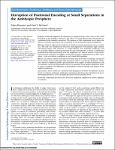Disruption of Positional Encoding at Small Separations in the Amblyopic Periphery
| dc.contributor.author | Hussain, Zahra | |
| dc.contributor.author | McGraw, PV | |
| dc.date.accessioned | 2023-05-10T08:29:14Z | |
| dc.date.available | 2023-05-10T08:29:14Z | |
| dc.date.issued | 2022-04-21 | |
| dc.identifier.issn | 1552-5783 | |
| dc.identifier.issn | 1552-5783 | |
| dc.identifier.other | ARTN 15 | |
| dc.identifier.uri | https://pearl.plymouth.ac.uk/handle/10026.1/20879 | |
| dc.description.abstract |
PURPOSE. Positional judgments in amblyopia are impaired more at the center of the visual field than in the periphery. However, the effects of visual field position frequently are confounded with stimulus separation. The purpose of this experiment was to parse the effects of stimulus separation and eccentricity on the positional deficit in amblyopia. METHODS. Subjects adjusted the positions of stimuli of varying separations on isoeccentric arcs. The task was simultaneous bisection and alignment of broadband, high-contrast, uncrowded targets with reference to central fixation. Ten strabismic amblyopes and five normally sighted controls performed the task dichoptically; a subset of amblyopes performed the task monocularly with the amblyopic eye. Spread (inverse of precision) and bias were measured at multiple visual field locations comprising two to three separation × four eccentricity conditions in each visual field quadrant. RESULTS. In normal controls, both spread and bias increased with eccentricity, and spread (but not bias) increased linearly with separation until 7° eccentricity. Strabismic amblyopes showed a different profile: spread and bias were higher at small separations at all eccentricities, such that performance showed a quadratic trend against separation. Thus, at each eccentricity, the difference in performance between groups was largest at the smallest separation. CONCLUSIONS. These results are consistent with disruptions in Weber mechanisms of positional encoding in strabismic amblyopia, and indicate that binocular stimulation by proximal targets produces a loss of spatial precision well beyond the fovea. | |
| dc.format.extent | 15-15 | |
| dc.format.medium | ||
| dc.language | en | |
| dc.publisher | Association for Research in Vision and Ophthalmology (ARVO) | |
| dc.subject | amblyopia | |
| dc.subject | precision | |
| dc.subject | bias | |
| dc.subject | bisection | |
| dc.subject | alignment | |
| dc.subject | suppression | |
| dc.subject | fusion | |
| dc.subject | diplopia | |
| dc.subject | eccentricity | |
| dc.title | Disruption of Positional Encoding at Small Separations in the Amblyopic Periphery | |
| dc.type | journal-article | |
| dc.type | Journal Article | |
| dc.type | Research Support, Non-U.S. Gov't | |
| plymouth.author-url | https://www.webofscience.com/api/gateway?GWVersion=2&SrcApp=PARTNER_APP&SrcAuth=LinksAMR&KeyUT=WOS:001000539300007&DestLinkType=FullRecord&DestApp=ALL_WOS&UsrCustomerID=11bb513d99f797142bcfeffcc58ea008 | |
| plymouth.issue | 4 | |
| plymouth.volume | 63 | |
| plymouth.publication-status | Published | |
| plymouth.journal | Investigative Opthalmology & Visual Science | |
| dc.identifier.doi | 10.1167/iovs.63.4.15 | |
| plymouth.organisational-group | |Plymouth | |
| plymouth.organisational-group | |Plymouth|Faculty of Health | |
| plymouth.organisational-group | |Plymouth|Faculty of Health|School of Psychology | |
| plymouth.organisational-group | |Plymouth|Users by role | |
| plymouth.organisational-group | |Plymouth|Users by role|Academics | |
| dc.publisher.place | United States | |
| dcterms.dateAccepted | 2022-03-14 | |
| dc.date.updated | 2023-05-10T08:29:14Z | |
| dc.rights.embargodate | 2023-8-16 | |
| dc.identifier.eissn | 1552-5783 | |
| dc.rights.embargoperiod | forever | |
| rioxxterms.versionofrecord | 10.1167/iovs.63.4.15 |


